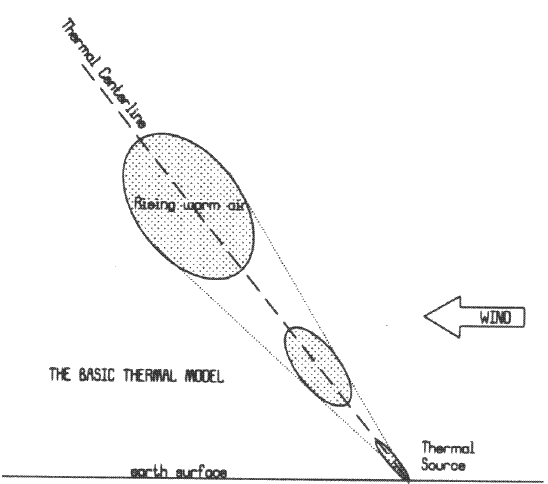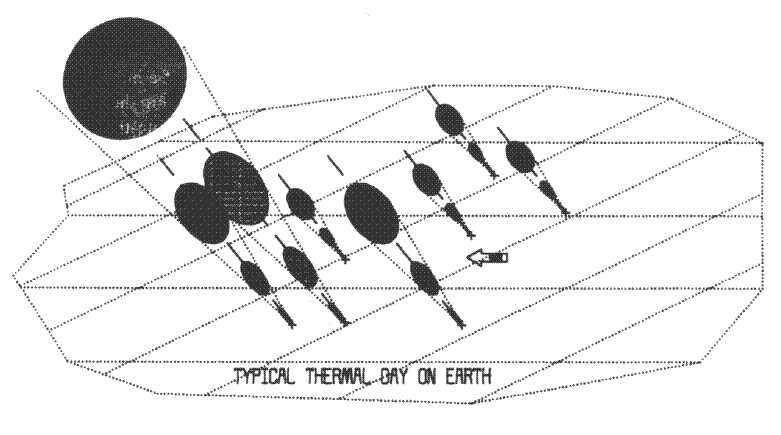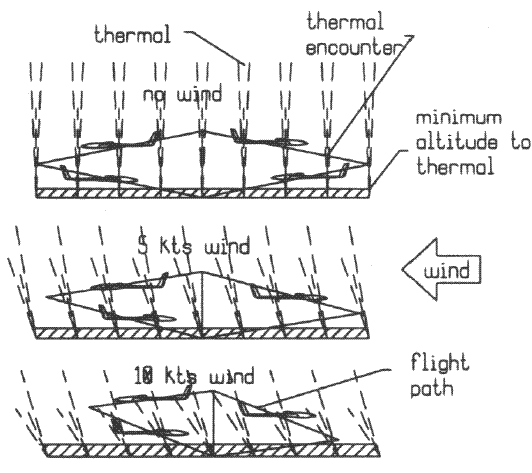By Frank Weston
Being in the right place at the right time is paramount in the world of thermal duration. In the last issue of Waco Technical Newsletter we told you how fast to fly, which is only one part of the solution to the problem of being somewhere. In this article we will present some ideas about where that somewhere is. Curiously, while speed to fly is mostly a statistical question, the issue of where to fly is mostly a relative one, i.e. where to fly relative to other competitors, to wind direction, to geographical features, to natural thermal indicators (airborne debris, smoke, fauna), to your position on the ground, even relative to previous experience. Let us examine the list of “where to be clues” in descending order of their value to you as a competition pilot.
Where to Fly Relative to Other Competitors.
The clues given by other competitors are not easy to miss or difficult to interpret, but there are some dangers, the most deadly of which is herd instinct. The desire to go where everyone else goes is very strong in humans. In soaring this desire must be controlled. Usually if a group of planes is circling, they’re in lift, and it is a good bet to join them. But be cautious! If the pilots are all herd animals, and if the lift is marginal to negative, the situation frequently arises where three, four, or even more planes are all circling in down air. All of these pilots are secure in the knowledge that they are circling where everyone else is. They are losers. Don’t get sucked in to joining them just because there is a crowd. Look, but go only if everyone really is going up, and only if they are within reach. Trust your own eyes and judgment. Consider this: if the crowd is in neutral air or going down, valuable intelligence is still to be gained. Stay away from them but look for signs of lift downwind of their location. Usually the herd picks a spot where there is lift and stays there long after the lift has moved on.
The antithesis of the herd animal is the lone wolf. This guy avoids the herd, even if it is rocketing skyward at Mach 5. He feels that any lift that he doesn’t find all by himself is tainted. This guy never wins contests. Don’t be a lone wolf or an ungulate. Be an opportunist. Take the easy pickings when they come along. In any decent contest you’ll have plenty of chances to demonstrate your real skill before the fat lady sings.
It is very important to know your competition. Some guys are always worth following, some never. Some guys can find and fly in lift that will do you no good; some are so rough that it is impossible to read the air they fly through. The more you watch other competitors the more you learn about the air, and about them as sources of intelligence. When the good guys are itching to get to a winch, you should look around and find out why. When they’re hiding in the parking lot, there is also usually a reason. If you are on a road trip, find out who the good local flyers are, then watch them.
A little “local knowledge” can go a long way. These guys fly this field all year long. Chances are they know the spots that work. If your competition is higher than launch height, he had to get there by flying in lift. Look for it. If your competition is higher than you, the column of lift he is in is usually upwind of him at lower altitude. Start your search upwind of his position. If he is lower, start downwind. If he is very, very much higher than you, chances are the lift has already gone. Make one pass through the likely area, and then get away quickly if you don’t find something. Big sink frequently follows strong lift. Use your ears as well as your eyes. If your competition is singing “Born Free”, chances are he has found big lift. If he is muttering obscenities or talking in panicked tones to his timer, stay away from his quadrant of the sky.
Where to Fly Relative to Wind Direction.
It is common knowledge that the streamer on your antenna will usually point to a thermal if there is one around. For example: If the wind has been steady, then suddenly there is a lull, or even a 180 degree shift, chances are there is a thermal moving in upwind. If your streamer begins to point left or right from average, chances are there is some thermal activity in the direction it is pointing. The streamer provides good information, but don’t rely on it for all of your decision-making. Sometimes you are too far away to take advantage of the information. If your plane is a half-mile away to the left, and suddenly your streamer moves right, don’t waste time chasing it. Sometimes the information itself is erroneous. On gusty, turbulent days, the wind direction can shift all over the compass and indicate nothing of real value. Did you ever notice that all of the really good pilots seem to end up way downwind on most of their flights? Moreover, the windier the day, the more they tend to head straight downwind right off the launch. Didn’t notice? Well, you should have, because there are some very, very good reasons to start a thermal search downwind.
Reason Number One: If you have been paying attention prior to your launch, you already know what conditions exist downwind. You have very few clues as to what’s upwind. The Devil you do know is better than the one you don’t. If the air prior to launch has been still, start your search overhead or downwind. If a major thermal came through within a minute prior your launch, go downwind to get it. DANGER! If a really big thermal comes through, and if it is moving fast, think twice before chasing it downwind. Really big, fast moving thermals leave nothing but down air in their wake, and unless you catch them you will be very low, very quickly, and land out very far
downwind. In this situation, the best course of action is to find something wrong with your radio just before launch and take about five minutes to fix it.
Reason Number Two: Light lift is easier to detect if the airplane is downwind. An airplane upwind is usually flown at a higher angle relative to the horizon than one flown downwind thus the horizon is of less use as a reference. Further, the upwind airplane drifts downwind increasing the angle relative to the horizon and giving a false impression of slight altitude gain. A downwind airplane always looks to be in trouble, and the lightest lift is far more readily detected.
Reason Number Three: The WACO Theory of Thermal Lines of Flux which asserts that you are more likely to find lift flying downwind than flying upwind. Assumptions (acknowledged as facts by most soaring pilots): Thermals are generated by randomly distributed sources such as roads, parking lots, automobile junk yards, large open dry fields, etc. On a good day, these sources will generate thermal after thermal at a cyclic rate determined by the amount of energy falling on the source, and the velocity and physical properties of the air moving over the source. 
Thermals move away from their source at a rate proportionate to wind speed and vertical speed of the thermal. As thermals move away from their source and gain altitude, they become stronger and larger until they reach an inversion layer or the stratosphere. Small lower thermals also tend to join other small low thermals to become bigger higher thermals. There is a minimum altitude at which a thermal can be detected and worked, and this minimum altitude decreases as wind increases. It is better to encounter a bigger thermal higher than a smaller thermal lower.
The figure adjacent is the basic thermal model. The thermal source can shed rising air bubbles at a rate ranging from nearly continuous to once daily. The rate at which the air bubble rises and expands is determined by the physical properties of the atmosphere and by the amount of energy contained within the rising air bubble or column. The direction in which the rising air moves is determined by the wind, the vertical speed of the bubble, and probably coriolis force, which for our purposes is not considered.
The figure below shows the random distribution of thermal sources, the different sizes of thermals, the joining of smaller thermals to create a larger one. What is not shown is the different rates at which thermals can generate, and their less than uniform movement and joining.
The middle figure, which portrays a 5kt breeze, shows that going upwind five thermals will be encountered; while going downwind, seven useable thermals will be encountered. This is only part of the story, since the thermals downwind will be encountered higher where they are wider, and stronger. The ratio of encounter downwind to upwind is 1.4. The bottom figure shows what happens when the wind picks up to 10 knots. Maybe four useable thermals are encountered going upwind, while six are encountered going downwind. The ratio of encounter downwind to upwind is 1.5. It would appear that the ratio of success downwind to upwind increases with wind speed!
Theory: The probability of encountering a workable thermal (given no other indications) is greater flying a downwind search pattern than flying an upwind pattern. The ratio of downwind to upwind probability of success decreases as wind strength decreases and is equal to one in zero wind conditions.
Reason number four: Most contests are held at the biggest, most level, most clear, most sundrenched field around. The field itself is probably the best source of thermals for miles. All of the thermals generated by the field on which you are standing will be either overhead or downwind. Except in the Midwest where fields are delineated only by other fields, a vertical barrier of some kind such as a tree line usually defines fields. It is impossible to fly an upwind tree line effectively. If you fly downwind, the downwind tree line is always available for some last minute scratching. A good pilot can lurk for minutes at 50 to 100 feet on a downwind tree line and wait for a thermal to break from the field. Try that upwind!
Where to Fly Relative to Your Own Position.
Don’t fly overhead unless you are carried there by a thermal! Lift is very difficult to detect when your plane is directly overhead; thus, a search pattern that passes overhead is not usually a good one. Further, looking straight up is a pain in the neck. If lift is overhead, you will want to fly in it, so if the lift overhead is not moving away, try moving yourself away. Don’t fly straight away or toward yourself when looking for lift. It is very difficult to see the plane, much less detect lift when viewing from end-on. The best search pattern is one that gives you a good side or quarter view of the model for most of the time.
Where to Fly Relative to Previous Experience.
If you had luck in a particular spot before, chances are you will find lift there again unless some major variables have changed. On your first launch you should consider the conditions and fly what you think is the search pattern with the highest probability of success. If you find lift, try the same search pattern on subsequent flights. If you have no success, next time out (unless there are indicators to the contrary) fly a different search pattern. For example: you know you want to search downwind to a tree line. If, on your first flight you go left and find no lift, next time at the winch, instead of running downwind to the left, try it to the right.
Where to Fly Relative to Geographical Features and Natural Thermal Indicators.
Geographical features which you should look for include: Roads, parking lots, rocky or dry fields, junk yards, tank farms, residential areas, and any other piece of real estate which has the capability to heat up under direct sun. Certain features are of more value during different times of the day. A hillside that receives the direct rays of the morning sun will be among the first locations to begin shedding thermals. This same hillside may be useless in the afternoon. Rocky or sandy areas may take longer to heat up, but will release stored heat late into the afternoon. Late in the afternoon on still days, wooded areas sometimes release weak thermals. Topographical irregularities such as tree lines, tall corn, steep hills, buildings, and anything else which will cause air to be disturbed can not only be good spots for slope lift, but also seem to be a catalyst for thermals.
Birds, like other competitors, are obvious indicators of lift. The best birds to watch are usually swallows or the like which swarm around insects being carried aloft by thermals. This type of bird is best, because they are there when the thermal is and gone the minute the thermal dissipates. They are a visible outline of the thermal. Buzzards and hawks, on the other hand, seem to hang around even after the lift is gone. Pay attention! If the buzzard is circling, chances are there is lift, but if Mr. Buzzard is flying straight and level, beware. Hawks calling to their mates are often a good thermal indicator. Usually you hear the call before you see the hawk, and it has been my experience that when they are calling it is when (or because) they are in lift. Look for the source of the noise. Seagulls are the worst of all birds for indicating lift. They’re so efficient, they can make down air look good. Worse, they tend to circle over landfills and dumpsters, over farmers plowing fields, and any other source of food, but not necessarily lift.
Thermal Tip from Country Bob
It is a little known fact that cows usually stand with their tails to the wind. Feeding birds also hang around cows to chow down on the insects the cows attract and/or stir up. The cow/insect/bird combo can be a potent weapon in the search for thermals. The cows indicate wind direction and shifts, and the birds chase insects up into the lift. Just remember, cows always look at lift.
Summary
If there are obvious and reliable indicators of lift, and if you can get to them with acceptable risk, go there. If there are no obvious indicators, but if you have had success in one area before, look there first. If there are no other indicators, search downwind, in a pattern that takes the plane to your left or right so that you have a good side or quarter view of the model. Look and listen, pay attention to wind shifts, other competitors, birds, insects and cows.



